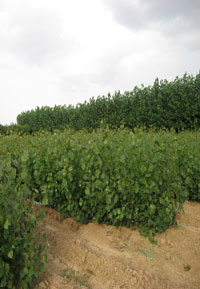| Sep 22, 2014 | |
Biotechnical procedure leads to increased biomass production from trees |
|
| (Nanowerk News) By modifying the gene expressions responsible for the branch growth during the first year of woody species, researchers of the Centre for Plant Biotechnology and Genomics (CBGP UPM-INIA), a joint centre of the Universidad Politécnica de Madrid (UPM) and the The National Institute for Agricultural Research and Experimentation (INIA), have found a way of increasing biomass production of a forest plantation without altering its growth, composition or the wood anatomy. | |
 A poplar plantation These results have an important market value for the bioenergy sector, thus this study was protected by patent (P201131186: Method for increasing or decreasing the development of sylleptic or proleptic branching in a ligneous plant). Lateral buds of most of the woody species in warm and cold areas do not sprout in the same season that they are born. These buds, called proleptics, remain latent and do not grow until the following spring. However, some lateral buds sprout during the same season such as poplar trees, other salicaceae species and many tropical species. This way, a syleptic branching can increase de amount of branches, leaf area and the tree growth in general, mainly during their first years of life. On that basis, researchers at UPM have used a biotechnological procedure to modify the gene expression levels of RAV1 (Related to ABI3 and Viviparous 1) that increases the development of sylleptic branching of woody species. Thus, researchers have found a way of increasing biomass production of a poplar plantation. This process of genetic modification is potentially applicable to any woody species and using their adaptive features to a particular habitat. These results are of great interest for the energy market. The biotechnological procedure used by these researchers can guarantee the biomass sustainable production yields of woody species without affecting food demand. These results can also mitigate the effects of global warming and to enhance energy security. |
| Source: Universidad Politécnica de Madrid |
